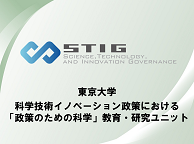イベント
日程変更:第41回STIG PoPセミナー:"Has India become more innovative since the onset of economic liberalisation?"
 日程変更:第41回STIG PoPセミナー:"Has India become more innovative since the onset of economic liberalisation?"" />
日程変更:第41回STIG PoPセミナー:"Has India become more innovative since the onset of economic liberalisation?"" />
日時:2016年5月23日(月) 6月1日(水)17:00~18:30
会場:東京大学本郷キャンパス 経済学研究科学術交流棟(小島ホール)第2セミナー室
講師:Dr Sunil Mani, the Centre for Development Studies, Trivandrum, Kerala, India
主催:東京大学科学技術イノベーション政策の科学(STIG)教育・研究ユニット
言語:英語(同時通訳はありません)
参加費:無料
参加お申し込みはこちらから
Abstract: Until 1991 India followed a policy of direct intervention in all matters related to economic activity. The country was subscribing to an important substituting strategy of becoming self-reliant in technology. However it never ever achieved that in any reasonable manner and her overall rate of growth of her economy never crossed what is now referred to as the "Hindu rate of growth". All this was to change in 1991 when the economy liberalized, albeit in an adhoc and unstructured manner. Direct intervention was replaced with indirect intervention as far as technology development was considered. The country also tried to alter her National System of Innovation (NSI) by placing private business enterprises almost at the core of her NSI. An outcome, although strongly debated within the country, has been, significant improvement in her overall economic growth performance so much say that India has now emerged as the fastest growing country in the world and is likely to remain at that exalted position for some more time in the future. She has also become the largest exporter of computer software services in the world since 2005, has become the sixth largest exporter of aircraft components and is usually referred to as 'pharmacy of the developing world' as far as her generic drugs industry is concerned. She has also become one of the most preferred location for R&D services by MNCs. But have India really become very innovative during this phase of liberalization? It is this important question that the seminar proposes to answer with the aid of numerous indicators for measuring a country's innovation performance as prescribed by the literature on economics of innovation. The presentation also seeks to unravel the feet that India needs to have to firmly place her on the sure path to technological dynamism.


